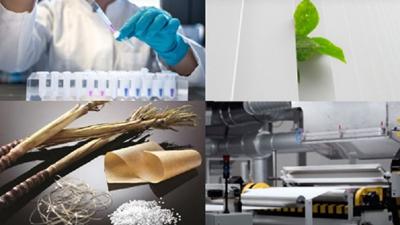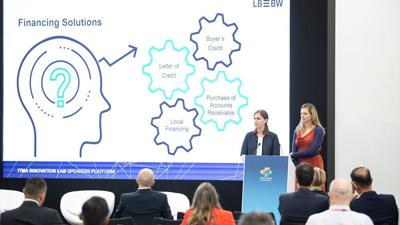Man-Made Fibers International 1/2023

Ernesto Maurer (Source: Cemetex)
Ahead of this year’s ITMA in Milan/Italy, the painful spike in energy costs in 2022 which will continue well into 2023 has intensified the ubiquitous focus on energy savings by textile technology developers – from the production of fibers through to garment making-up.
Dyeing and finishing
The most energy-consuming areas in the textile manufacturing chain, can be found in dyeing and finishing, involving many stages of washing and drying that also consume considerable amounts of water and chemicals.
Textile machinery builders have already made great progress here – the development of dyeing machines in terms of design and control technology has led to a substantial reduction in water consumption over the past few decades.
On average, the finishing stages of pre-treatment, dyeing and after-treatment required about 100 l of water per kg of cotton in 1980. Today, the best-available technologies achieve on average 28 l/kg on medium shades – a 72% improvement. The reduction of water, of course, relates directly to savings in energy as well as reduction of waste.
Dual heating
At the ITMA 2023, however, visitors will discover that much more can be achieved, with machine builders now supplying dual heating systems such as combinations of gas and steam or gas and oil in order to become less dependent on gas, for example. Steam and thermal oil are also being heated with carbon-neutral biomass and the systems for recycling waste heat from drying processes are proving more invaluable than ever.
Many new examples of minimum application technologies for both the dyeing and finishing of textiles involving fully digitalized precision spray technologies will also be on show in Milan, making further huge savings possible.
The most energy-consuming areas in the textile manufacturing chain, can be found in dyeing and finishing, involving many stages of washing and drying that also consume considerable amounts of water and chemicals.
Textile machinery builders have already made great progress here – the development of dyeing machines in terms of design and control technology has led to a substantial reduction in water consumption over the past few decades.
On average, the finishing stages of pre-treatment, dyeing and after-treatment required about 100 l of water per kg of cotton in 1980. Today, the best-available technologies achieve on average 28 l/kg on medium shades – a 72% improvement. The reduction of water, of course, relates directly to savings in energy as well as reduction of waste.
Dual heating
At the ITMA 2023, however, visitors will discover that much more can be achieved, with machine builders now supplying dual heating systems such as combinations of gas and steam or gas and oil in order to become less dependent on gas, for example. Steam and thermal oil are also being heated with carbon-neutral biomass and the systems for recycling waste heat from drying processes are proving more invaluable than ever.
Many new examples of minimum application technologies for both the dyeing and finishing of textiles involving fully digitalized precision spray technologies will also be on show in Milan, making further huge savings possible.
Digitalization
It will also be very apparent at the ITMA exhibition that the time for the further digitalization of the fiber spinning industry – as the route to establishing greater efficiencies in all resource inputs – is now.
A lot of things have changed very quickly as a result of the establishment of global networks and centralized processing and storage. Combine these with the huge progress that is being made in respect of sensor identification technology, data analytics, mobile and wireless communication and machine learning and we would be looking at significant disruption. All these developments address resource efficiency as well as problems such as low margins and the lack of skilled labor that have been seen in the textile sector.
Regional differences
PricewaterhouseCoopers presented a study based on more than 2,000 participating companies from 9 sectors of industry in 26 countries, including textile manufacturers. Therein they emphasized that digitalization is not just engaging companies in already fully-industrialized countries, but also in developing ones, with emerging economies having somewhat different aims. In Europe, for example, the main goal is to expand operational efficiency and product quality. China and other Asian countries are meanwhile seeking to benefit from automating and digitalizing their labor-intensive manufacturing processes.
As far as the commoditized textile industry is concerned, digitalization is also rapidly enabling systems for the customized ordering of apparel online, along with delivery with very short lead times. Thus, being a form of manufacturing becoming increasingly profitable for manufacturers, as production and logistics processes are extensively automated.
Reshoring and circularity
A further noticeable shift now being driven by digitalization is to so-called ‘reshoring’. After Covid-19-related closed borders, reduced production capacity and general global uncertainty, many companies started to question the norm of outsourcing production, involving complex and fragile supply chains.
Bringing production closer to home has never before been as feasible as it is today, due to the increased automation and robotization of many production processes. This will be very evident at the ITMA 2023.
So too, will be a growing emphasis on circular supply chains and new technologies to rapidly advance the apparel recycling industry. Here, the emphasis is now on chemical recycling routes and full materials recovery, along with digitalized separation and sorting.
It is anticipated, for example, that between 150 and 250 new textile recycling centers will be established within Europe in the next 5 years, in response to the European Green Deal. The European Union’s plans to make Europe the first climate-neutral continent will also have a major impact on chemical usage in the textile industry. The ITMA 2023 will provide a window into this fast-moving world. Come June, the more than 1,600 exhibitors from 44 countries are all set to showcase their innovative offerings at the first large-scale textile machinery exhibition post-pandemic. Held alongside the exhibition will be the ITMA Textile Colourants and Chemicals Forum and the ITMA Nonwovens Forum.
Ernesto Maurer
President CEMATEX
Brussels/Belgium
President CEMATEX
Brussels/Belgium



